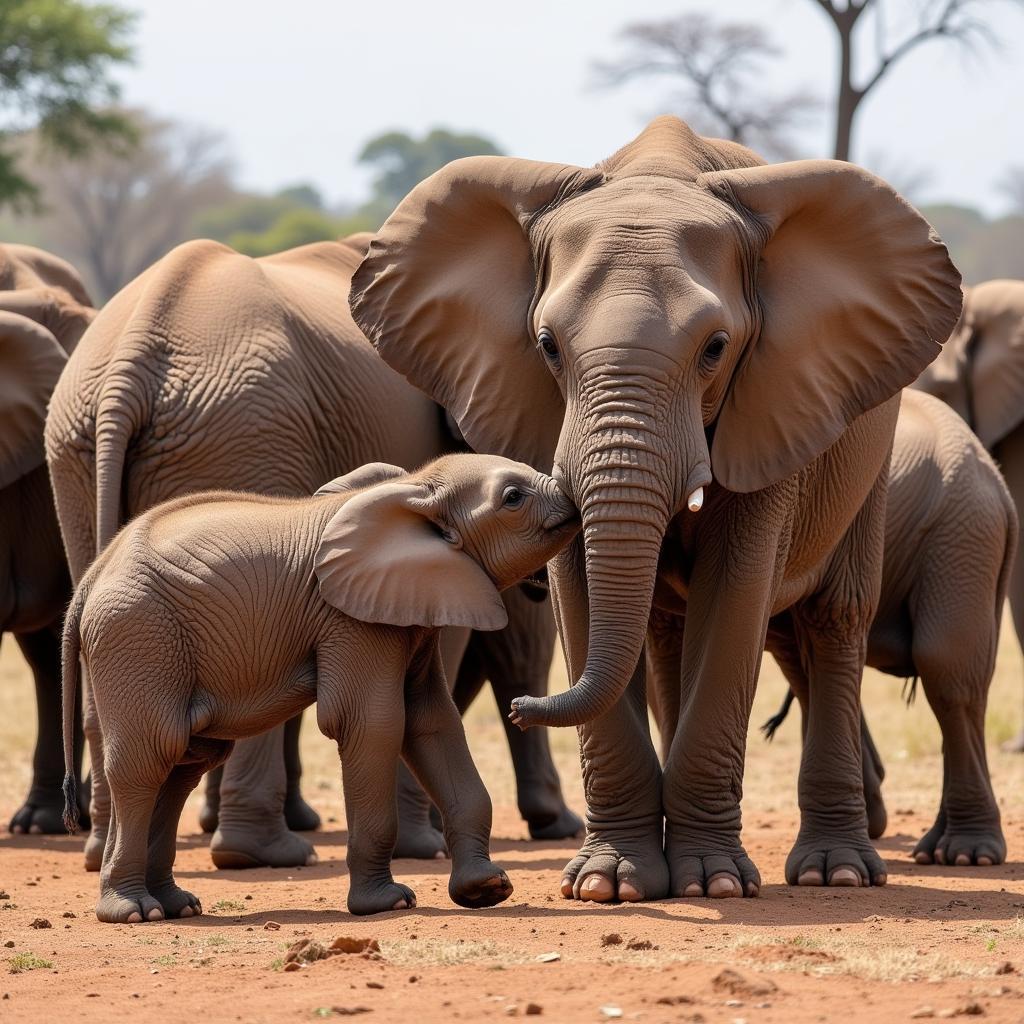The Miracle of African Elephant Birth
African Elephant Birth is a momentous occasion, a testament to the enduring power of nature. Witnessing the arrival of a new calf into the elephant herd is a truly remarkable experience. After a nearly two-year gestation period, the longest of any mammal, a new life emerges, weighing in at a staggering 200 pounds. This article delves into the fascinating process of African elephant birth, exploring the biological marvels, social dynamics, and conservation challenges surrounding this crucial event.
 African Elephant Mother and Calf Moments After Birth
African Elephant Mother and Calf Moments After Birth
The Long Journey: Gestation and Preparation for African Elephant Birth
The African elephant’s gestation period is an extraordinary 22 months. During this time, the female, known as a cow, undergoes significant physical and hormonal changes to support the developing calf. The expectant mother seeks out nutrient-rich vegetation to nourish herself and her growing baby. As the birth approaches, the other females in the herd, often related to the expectant mother, form a protective circle, shielding her from potential predators. african elephant giving birth offers a glimpse into this protective behavior.
What triggers labor in African elephants?
While the precise trigger for labor in African elephants isn’t fully understood, hormonal changes, similar to those in other mammals, play a key role. The timing often coincides with periods of abundant food and water resources, ensuring the newborn has the best chance of survival.
How long does labor typically last?
Labor can vary in duration, but it typically lasts several hours. The entire herd participates, offering encouragement and support to the laboring mother. They may trumpet, rumble, and touch the mother with their trunks, creating a powerful sense of community.
Welcoming the Newborn: The Birth Process
The actual birth is a powerful and often dramatic event. The cow may stand, lie down, or even lean against a tree during labor. african elephant weight at birth reveals just how substantial these newborns are. The other females in the herd act as midwives, assisting the mother and cleaning the newborn calf. The calf, still wobbly on its legs, instinctively seeks out its mother’s milk, crucial for its development and immunity.
A Life in the Herd: Early Development and Social Bonds
The first few days and weeks of a calf’s life are critical. It must learn to walk, to nurse, and to navigate the complex social dynamics of the herd. The calf relies entirely on its mother’s milk for nourishment. It quickly forms strong bonds with its mother and other members of the herd, learning vital survival skills and social cues. Comparing african elephant baby indian elephant baby highlights the unique characteristics of each species.
How does the herd protect the newborn calf?
The entire herd plays a crucial role in protecting the vulnerable calf from predators such as lions and hyenas. They form a protective barrier around the calf, especially during its first few months of life. Older siblings, known as allomothers, also contribute to the calf’s care.
Dr. Naomi Mwangi, a renowned wildlife biologist specializing in African elephant behavior, explains, “The allomothering behavior in elephants is fascinating. It demonstrates the strong social bonds and cooperative nature within the herd, crucial for calf survival.”
african elephant with calf beautifully showcases this protective bond. The herd’s collective care significantly increases the calf’s chances of survival in the harsh African savannah.
Conservation Concerns: Protecting the Future of African Elephant Births
Sadly, African elephants face numerous threats, including habitat loss and poaching, impacting their ability to reproduce and raise their young successfully. Dr. Mwangi adds, “Protecting elephant habitats and combating poaching are essential to ensure the future of these magnificent creatures.”
What can be done to help protect African elephants?
Supporting conservation organizations, raising awareness about the threats elephants face, and advocating for stronger anti-poaching measures are crucial steps in ensuring the survival of these magnificent animals and the miracle of African elephant birth for generations to come. african bush elephant female highlights the critical role females play in the herd’s survival.
Conclusion
African elephant birth is a powerful symbol of life and resilience. By understanding the intricacies of this event and the challenges these majestic animals face, we can all contribute to their conservation and ensure that future generations can witness the wonder of new life in the African savannah.
FAQ
- How often do African elephants give birth?
- What is the role of the allomothers in the herd?
- What are the main threats to African elephant populations?
- How long do African elephant calves stay with their mothers?
- What is the significance of the herd’s protective behavior during birth?
- How does the timing of birth relate to resource availability?
- What are some ongoing conservation efforts to protect African elephants?
For any further inquiries or support in contributing to African elephant conservation, please contact us. Phone: +255768904061, Email: kaka.mag@gmail.com, Address: Mbarali DC Mawindi, Kangaga, Tanzania. Our customer care team is available 24/7.
